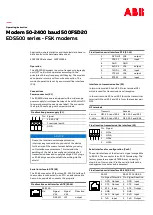
- 13 -
TC1630R/S User's Manual
Rev. 2.5
Cable Connection Verification
Electrical Cables:
1.
Make sure all electrical signal connections match the pin assignments (I/O) for the device (check User's
Manual if necessary).
2.
Verify signal connections by checking the status LEDs on the front panel of the TC1630R/S. If the
"LLOS" LED is flashing, a transmit signal is not being detected from the local device. If the "RLOS"
LED is flashing, no response signal is being detected from the remote device.
3.
Verify that the correct Line Code setting (and Line Length setting for T1) has been configured and that
the appropriate LEDs light to match the setting selected.
4.
Conduct a Local Loopback Test to help isolate an electrical interface problem (see Chapter 4 - Bench
Tests).
Optic Cables:
If the "SYNC" LED on the front panel is flashing or Off, this is an indication that the optic signal is not being
correctly received. Usually, unsecured fiber optic connectors or faulty cable are to blame. A good
connection is indicated by the "SYNC" LED on the front panel being solidly lit. This indicates that the
receiving cable is correctly connected to Remote unit's optic "Tx."
Dry Contact Alarm Relay
TC1630 has built-inDry contact relay switch. The status is for the relay switch is "normal open". It is
triggered by following major alarm conditions:
Optic signal lost
Local T1/E1 signal lost
Local user's T1/E1 device is sending "mark" data pattern
Local user's T1/E1 device's signal is causing bipolar violations
Invalid line code setting
Invalid line length setting
The electrical rating for the dry contact relay switch is
50VDC max
500 mA max.
switching power is 10 watts max.








































